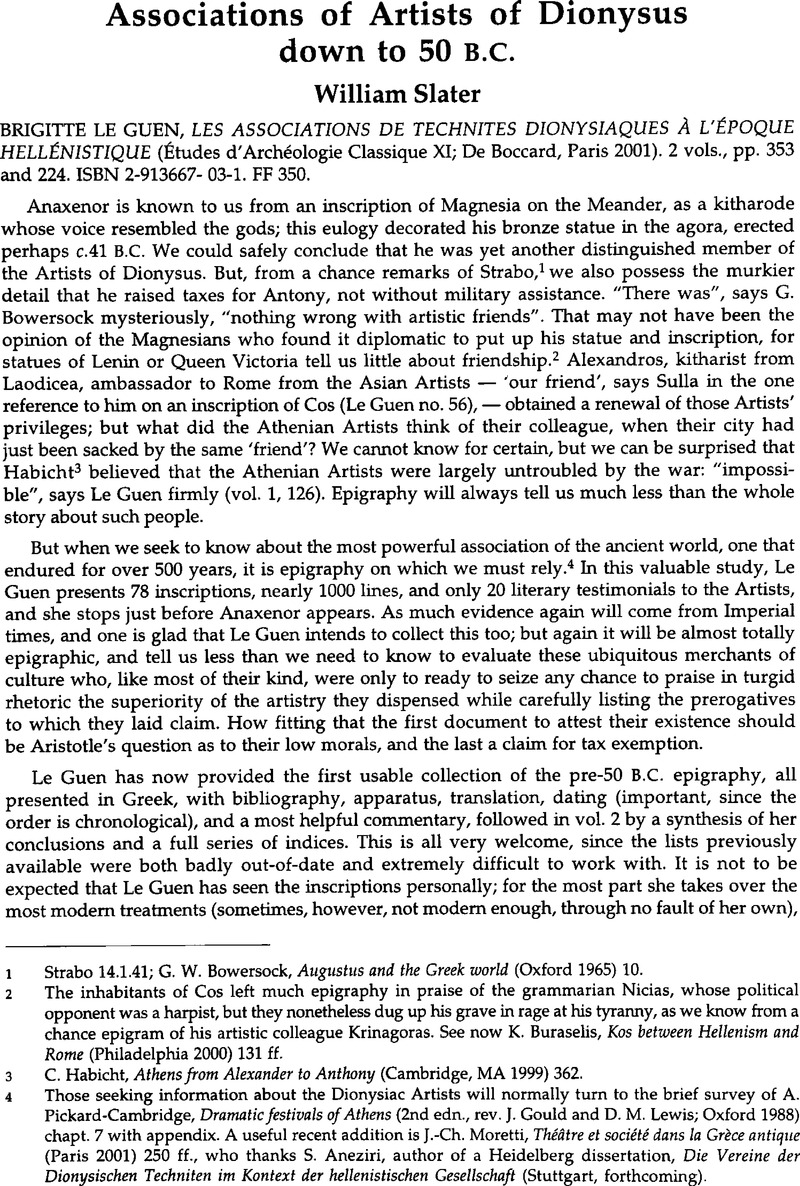Article contents
Associations of Artists of Dionysus down to 50 B.C. - Brigitte le Guen, LES ASSOCIATIONS DE TECHNITES DIONYSIAQUES À L'ÉPOQUE HELLÉNISTIQUE (Études d'Archéologie Classique XI; De Boccard, Paris 2001). 2 vols., pp. 353 and 224. ISBN 2-913667-03-1. FF 350.
Published online by Cambridge University Press: 16 February 2015
Abstract

- Type
- Reviews
- Information
- Copyright
- Copyright © Journal of Roman Archaeology L.L.C. 2002
References
1 Strabo 14.1.41; Bowersock, G. W., Augustus and the Greek world (Oxford 1965) 10 Google Scholar.
2 The inhabitants of Cos left much epigraphy in praise of the grammarian Nicias, whose political opponent was a harpist, but they nonetheless dug up his grave in rage at his tyranny, as we know from a chance epigram of his artistic colleague Krinagoras. See now Buraselis, K., Kos between Hellenism and Rome (Philadelphia 2000) 131 ffGoogle Scholar.
3 Habicht, C. Athens from Alexander to Anthony (Cambridge, MA 1999) 362 Google Scholar.
4 Those seeking information about the Dionysiac Artists will normally turn to the brief survey of Pickard-Cambridge, A., Dramatic festivals of Athens (2nd edn., rev. Gould, J. and Lewis, D. M.; Oxford 1988) chapt. 7 with appendixGoogle Scholar. A useful recent addition is Moretti, J.-Ch., Théâtre et société dans la Grèce antique (Paris 2001) 250 ff.Google Scholar, who thanks Aneziri, S., author of a Heidelberg dissertation, Die Vereine der Dionysischen Techniten im Kontext der hellenistischen Gesellschaft (Stuttgart, forthcoming)Google Scholar.
5 She cites Lefèvre's forthcoming CID 4, and often notes information not currently available, especially for Delphi.
6 Habicht, C., “Eine Urkunde des Akarnanischen Bundes,” Hermes 85 (1957) 86–122 Google Scholar.
7 Stefanis, I. E., Dionysiakoi technitai (Heraklion 1988)Google Scholar.
8 It is most regrettable that Ch. Kritzas has still not found time to publish the letter of the proconsul Q. Fabius Q.f. Maximus to the city of Dyme in 144, confirming the privileges of the Artists and providing other information from this critical period; it is now 30 years since it was discovered in Argos. Similar delays in making available (even to Greek colleagues) major texts from Dion and Amphipolis are having at least one effect: students of the ancient world are losing interest in doing research in the raw material of Greek culture. Soon there will be few left who can read such documents.
9 Leppin, H., Histrionen (Bonn 1992)Google Scholar.
10 Stefanis, I. E., EEThess 22 (1984) 499–564 Google Scholar.
- 1
- Cited by


